You can use pivot_wider from tidyr:
library(tidyr)
pivot_wider(df, names_from = date, values_from = rel_spread, values_fn = list) %>%
unnest(everything())
#> # A tibble: 2 x 17
#> `20000103` `20000104` `20000105` `20000106` `20000107` `20000108` `20000109`
#> <dbl> <dbl> <dbl> <dbl> <dbl> <dbl> <dbl>
#> 1 -0.0234 -0.0128 0.00729 0.0408 -0.0298 0.0398 0.0445
#> 2 0.0492 -0.0120 0.0277 0.0435 -0.0288 0.0152 -0.0374
#> # ... with 10 more variables: `20000110` <dbl>, `20000111` <dbl>,
#> # `20000112` <dbl>, `20000113` <dbl>, `20000114` <dbl>, `20000115` <dbl>,
#> # `20000116` <dbl>, `20000117` <dbl>, `20000118` <dbl>, `20000119` <dbl>
Note that we don't have your data (and I wasn't about to transcribe a picture of your data), but I created a little reproducible data set which should match the structure of your data set, except it only has two values per date for demo purposes:
set.seed(1)
df <- data.frame(date = rep(as.character(20000103:20000119), 2),
rel_spread = runif(34, -0.05, 0.05))
df
#> date rel_spread
#> 1 20000103 -0.0234491337
#> 2 20000104 -0.0127876100
#> 3 20000105 0.0072853363
#> 4 20000106 0.0408207790
#> 5 20000107 -0.0298318069
#> 6 20000108 0.0398389685
#> 7 20000109 0.0444675269
#> 8 20000110 0.0160797792
#> 9 20000111 0.0129114044
#> 10 20000112 -0.0438213730
#> 11 20000113 -0.0294025425
#> 12 20000114 -0.0323443247
#> 13 20000115 0.0187022847
#> 14 20000116 -0.0115896282
#> 15 20000117 0.0269841420
#> 16 20000118 -0.0002300758
#> 17 20000119 0.0217618508
#> 18 20000103 0.0491906095
#> 19 20000104 -0.0119964821
#> 20 20000105 0.0277445221
#> 21 20000106 0.0434705231
#> 22 20000107 -0.0287857479
#> 23 20000108 0.0151673766
#> 24 20000109 -0.0374444904
#> 25 20000110 -0.0232779331
#> 26 20000111 -0.0113885907
#> 27 20000112 -0.0486609667
#> 28 20000113 -0.0117612043
#> 29 20000114 0.0369690846
#> 30 20000115 -0.0159651003
#> 31 20000116 -0.0017919885
#> 32 20000117 0.0099565825
#> 33 20000118 -0.0006458693
#> 34 20000119 -0.0313782399
